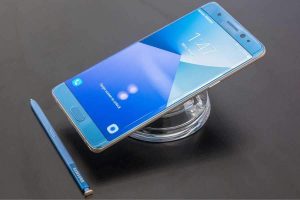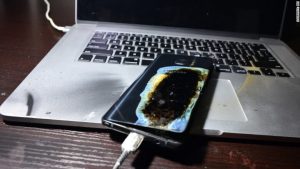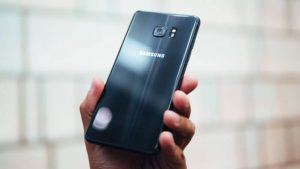Some of you might have already experienced the exploding Samsung Galaxy Note 7, but now new reports have emerged about the new Samsung Galaxy Note 7 smartphones, while not exploding, overheating as well.
There is no easy way to put it. Despite initial positive reviews, the launch of Samsung Galaxy Note 7 has been an absolute train wreck for Samsung.
Not only that but Samsung Galaxy Note 7 is also one of the few smartphones in the market that has made more headlines about spontaneously combusting in people’s pockets, vehicles, houses, and airplanes than it has because of all its “new and cool” features.
Samsung showed some form of composure when it ordered a global recall of Samsung Galaxy Note 7, but, as we now know, that also turned into a nightmare.
What’s more? The replaced Samsung Galaxy Note 7’s are also giving users overheating problems.
According to a report by the Wall Street Journal, it has been revealed that Samsung has further plunged into darkness as a premier smartphone brand because of the company’s recent woes. User complaints are now pouring in about the new Samsung Galaxy Note 7 overheating problems.
Just to be clear, the new Samsung Galaxy Note 7 isn’t actually a new smartphone altogether. Perhaps the term “replaced Samsung Galaxy Note 7 “ is more appropriate since the current Samsung Galaxy Note 7 is just a non-exploding version of the original Samsung Galaxy Note 7.
As mentioned before, various reports are now indicating that people who went through the painful process of requesting a replaced Samsung Galaxy Note 7 smartphone device, are still unable to handle the replaced Samsung Galaxy Note 7 because of the smartphone being too hot during routine phone calls.
The situation cannot be bizarre enough as Samsung has had to even substitute, in a few cases,the replaced Samsung Galaxy Note 7 smartphones.
Of course, overheating Samsung Galaxy Note 7 smartphone are nothing new. Now, the case is also becoming true for the replaced Samsung Galaxy Note 7 as well.
In fact, the overheating issue of replaced Samsung Galaxy Note 7 is just one of the many issues users have endured in their replaced Samsung smartphone devices.
Gizmodo reported that many of its readers experienced a number of issues regarding the Samsung replacement process itself.
In one of the reader complaints received by Gizmodo, it was reported that aNote 7 owner called Verizon customer service for a replacement Samsung Galaxy Note 7 device but was told to call Samsung directly.
After that, the Note 7 owner was directed back to Verizon by Samsung.

Samsung replaced its faulty new Note 7 smartphone. Now it needs to replace the replaced faulty Note 7 smartphone.
This Note 7 owner told Gizmodo he had no idea of what to expect. When the exploding Note 7 owner was finally able to log in a new Samsung Note 7 request through Verizon, he wrote to Gizmodo that Samsung treated him like absolute garbage over the entire replacement process and it all stemmed from the fact that he bought his piece of Samsung Galaxy Note 7 through a third party seller.
If that wasn’t enough then another Note 7 owner who wrote to Gizmodo complaining about his experience with Verizon while trying to get his fault smartphone replaced by Samsung.
He wrote that if anyone was past due at all, they couldn’t (or rather wouldn’t) touch it. In an email sent to Gizmodo the same Note 7 owner also said that in addition to that problem, if the smartphone was purchased online, then anyone should expect his/her bank account to be tied up for several days because when a user returned their smartphone device, Samsung re-charged the user’s bank account after supposedly refunding what the user already paid for the smartphone.
One can only hope that Samsung can overcome this overheating issue in its entirety, preferably as early as possible. Perhaps getting rid of the entire 2.5 million or so Samsung Galaxy Note 7 smartphones was the best policy.
But Hang On Note 7 Owners, Samsung’s Smartphones Aren’t The Only Machines (in Your Home) That Can Explode
Samsung washing machine owners should be on their guards because the washing machine from Samsung, just like Samsung Galaxy Note 7, can explode.
Needless to say, but this just adds to the laundry list of problems Samsung is already facing with regards to exploding Samsung Galaxy Note 7 and overheating replacement Samsung Galaxy Note 7.
A couple of days ago, the Consumer Product Safety Commission stated that the agency was inspecting a few of Samsung’s top-loading washing machines. The authority further added that it had reason to believe that Samsung washing machine might have safety issues which the company had never bothered to publicize.
According to the statement put out by Consumer Product Safety Commission, it was said that the Consumer Product Safety Commission was advising consumers to only use the delicate cycle when washing bedding, water-resistant and bulky items.
The statement further added that the lower spin speed in the delicate cycle lessened the risk of impact injuries or property damage due to the washing machine becoming dislodged.
However, the Consumer Product Safety Commission did not divulge upon the specifics of which Samsung washing machine model the agency was inspecting. But it did note that the agency, in its inspections, included Samsung washing machines that were manufactured between March 2011 and April 2016.
The independent agency of the United States government warning about Samsung washing machines has come up in the media a few months after some customers filed a class-action lawsuit against the company that made their washing machines.
According to the lawsuit, the customers complained about their machines exploding.
Law360, which is a subscription-based legal news service operated by the Portfolio Media company, reported on the lawsuit related to Samsung washing machines back in march and said that the Indiana resident Suzanne Moore and Texas resident Michelle Soto Fielder complained that Samsung Electronics America Inc exposed the two washing machine owners to unreasonable harm and unjustly received their money by selling them brand-new washing machines that exploded violently in their homes just a few years later which caused significant damage.
About a year ago, abc11.com also published a report that detailed the exploding Samsung washing machines.
Samsung put up a statement on its official website which said that the company was in active discussions with Consumer Product Safety Commission over the exploding Samsung washing machines issue.
The company then went ahead and released another statement that read almost exactly the same as the previous one to the Consumer Product Safety Commission a couple of days ago.
Samsung’s second statement said that in rare cases, affected units might have experienced abnormal vibrations that could have posed a risk of personal injury or property damage when washing bedding, bulky or water resistant items.
The statement also read that Samsung was recommending that consumers with affected washing machine models should use the lower speed delicate cycle when washing bedding, bulky or water-resistant materials.
The company further added there had been no reported incidents when using the abovementioned cycle.
As mentioned before, the exploding washing machine issue could not have come up at a worse time for Samsung as the company still has not even begun to recover from the disaster that was Samsung Galaxy Note 7.
The washing machine issue along with the exploding Samsung Galaxy Note 7 problem and replaced Samsung Galaxy Note 7 overheating complications are just some of the snags Samsung can’t’ just get rid of.
It Might Sound Surprising, But Samsung Isn’t The Only Tech Company That Has Been Trying To “Scam” Its Customers.
It looks like September is proving to be quite a tough month for technology companies.
Samsung keeps getting hit by a large number of consumer complaints regarding its smartphone devices and washing machines to which the company just hasn’t been able to respond with appropriate solutions.
HP (Hewlett-Packard), an American multinational information technology company headquartered in Palo Alto, has now apologized for destroying consumers’ printers on purpose.
Yeah, the news is one hundred percent true and this isn’t a parody site like this one over here.
To the company’s credit, HP did apologize for deliberately rolling out a software update to the various HP printers that customers had bought.
Some might think that software updates are a good thing. They keep electronics safe from cyber attacks and make the machine run faster (generally).
However, in HP’s case, the new software update actually blocked customers from using non-HP printer ink with their HP printers.
The guardian broke the news last week and reported that HP’s automatic software update disabled some of the company’s printers (sold to customers of course, not the ones inside the company’s headquarters for example) in terms of performing printing functions with non-HP ink cartridges.
In other words, the printers were effectively prevented from performing printing tasks with cartridges that were not manufactured by HP.
Moreover, if consumers inserted a non-HP ink cartridge into their printers, they were prompted with a warning message. However, it was revealed that the same printers worked flawlessly when printing tasks were performed with an official HP ink cartridge.
Of course, no one needs to explain why this action from HP isn’t acceptable. HP faced a severe backlash from consumers and consumer rights groups when the news about the company purposely preventing printers from printing with non-HP inks broke out.
This past Monday, the EFF sent a letter to HP ink and implored the company to change its stance on HP printers being able to use non-HP ink cartridges.
The official letter from EFF stated that HP customers should be able to use the ink of their choosing in their printers for the same reason that Cuisinart customer should be able to choose whose bread goes in their toasters.
The letter further read that the practice of “tying” was rightly decried by economists and competition regulators as an invitation to monopoly pricing and reduce competition and innovation.
EFF’s letter also communicated that HP customers should be able to choose HP ink because it was the best, not because their printer won’t work with a competitor’s brand.
By the time Wednesday came about, over 10,000 consumers had participated in EFF’s call to action.
Additionally, HP forums were flooded with user complaints regarding the company’s unfair methods of forcing customers to buy HP ink cartridges.
Again, to the company’s credit, HP listened to disgruntled customers and Jon Flaxman, the Chief Operating Officer at HP Inc., wrote a blog post to address the problem.
In the blog post, it was said that as was standard in the printing business, HP had a process for authenticating supplies and that the most recent firmware update included a dynamic security feature that prevented some untested third-party cartridges that used cloned security chips from working, even if they had previously functioned properly.
The blog post further read that HP should have done a better job of communicating about the authentication procedure to customers and the company apologized for the error.
However, Flaxman also noted that only a small number of customers were affected but for HP one customer who had a poor experience was one too many.
It is still unclear if Flaxman, and HP, regret the company’s decision on rendering a functional product useless because of a proprietary component. The blog post also didn’t say much about whether HP would reverse the effects of the new automatic software update for its printers.
However, the blog post did say that as a remedy for the small number of affected customers, the company would issue an optional firmware update that would remove the dynamic security feature.
HP further added that the company expected the update to be ready within two weeks and would provide the details of the process here.
The company said that in the meantime, customers with immediate care issues could reach HP at a dedicated support center- [email protected]
In short, HP printer owners have some good news and some bad news. The good news is that users whose printers were jammed because of the new update will receive the another new update which will, hopefully, disable the “dynamic security feature” on their machines and they will be able to, once again, use third-party ink cartridges.
The bad news is that HP is likely to stay determined on its DRM practices.
Aside from HP’s unreasonable demand of using official HP printers, you can check out our review of various HP printers here, here and here.
But if you’re put off by the whole DRM thing with HP printers, then check our HP laptop reviews here, here, and here.
- How to Pair a Vizio TV to Bluetooth Speakers – Quick and Easy - March 28, 2022
- How to Update iPhone Without WiFi - March 17, 2022
- What Is the Need for Businesses to Invest in Hiring for Java Development? - March 14, 2022



